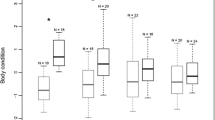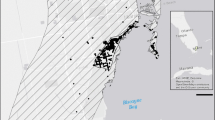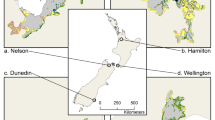Abstract
Context
Development and survival vary across a species’ geographic range and are also affected by local conditions like urban warming, which may drive changes in biology that magnify or reduce the risks of hazardous organisms to people. Larvae of the pine processionary moth (Thaumetopoea pityocampa Schiff; PPM) are covered with setae (hair-like structures) that cause allergic reactions in warm-blooded vertebrates upon contact with the skin, eyes, or respiratory tract.
Objectives
Our objective was to determine whether PPM larva development, phenology, and survival change with urban warming in ways that affect the risks of this organism to people.
Methods
In Orléans, France, we conducted a field study of PPM larvae across a gradient of urbanization from forests to city center to measure winter survival and the timing and duration of the life stage that poses the greatest risk to people.
Results
Larvae in the city spent more time in the fifth, most dangerous, instar than larvae in the forest. Urban warming indirectly increased larva survival by advancing phenology of urban larvae to a more cold-tolerant life stage prior to the winter cold period. Our results indicate that local urban warming drives changes in larva biology that increase the risks the organisms pose to people.
Conclusions
In recent decades, the PPM has expanded its geographic range to higher latitudes with rising temperatures. Our study highlights that local landscape variation, such as a mosaic of warmer and cooler temperatures in cities, can alter the effects of this type of range expansion for people.





Similar content being viewed by others
Data availability
The datasets generated during and/or analyzed during the current study are available from the corresponding author on reasonable request.
Code availability
The R code used to analyze data for the study is available from the corresponding author on reasonable request.
References
Atkinson D (1994) Temperature and organism size—A biological law for ectotherms? Adv Ecol Res 25:1–58
Bale JS, Hayward SAL (2010) Insect overwintering in a changing climate. J Exp Biol 213:980–994
Bates D, Maechler M, Bolker B, Walker S (2015) Fitting linear mixed-effects models using lme4. J Stat Softw 67:1–48
Battisti A, Stastny M, Netherer S, Robinet C, Schopf A, Roques A, Larsson S (2005) Expansion of geographic range in the pine processionary moth caused by increased winter temperatures. Ecol Appl 15:2084–2096
Battisti A, Avcı M, Avtzis DN, Ben Jamaa ML, Berardi L, Berretima W, Branco M, Chakali G, El Alaoui El Fels, Frérot MA, Hódar B, JA Ionescu-Malancus I, Ipekdal K, Larsson S, Manole T, Mendel Z, Meurisse N, Mirchev P, Nemer N, Paiva MR, Pino J, Protasov A, Rahim N, Rousselet J, Santos H, Sauvard D, Schopf A, Simonato M, Yart A, Zamoum M (2015) Natural history of the processionary moths (Thaumetopoea spp.): new insights in relation to climate change. In: Roques A (ed) Processionary moths and climate change: an update. Springer, Dordrecht, pp 15–79
Battisti A, Larsson S, Roques A (2017) Processionary moths and associated urtication risk: Global change–driven effects. Annu Rev Entomol 62:323–342
Bjornstad O (2018) ncf: spatial covariance functions. R Packag version 12-6
Chown SL, Duffy GA (2015) Thermal physiology and urbanization: perspectives on exit, entry and transformation rules. Funct Ecol 29:902–912
Colacci M, Kavallieratos NG, Athanassiou CG, Boukouvala MC, Rumbos CI, Kontodimas DC, Pardo D, Sancho J, Benavent-Fernández E, Gálvez-Settier S, Sciarretta A, Trematerra P (2018) Management of the pine processionary moth, Thaumetopoea pityocampa (Lepidoptera: Thaumetopoeidae), in urban and suburban areas: trials with trunk barrier and adhesive barrier trap devices. J Econ Entomol 111:227–238
Dale AG, Frank SD (2014) Urban warming trumps natural enemy regulation of herbivorous pests. Ecol Appl 24:1596–1607
Diamond SE, Cayton H, Wepprich T, Jenkins CN, Dunn RR, Haddad NM, Ries L (2014) Unexpected phenological responses of butterflies to the interaction of urbanization and geographic temperature. Ecology 95:2613–2621
ESRI (2011) ArcGIS Desktop: Release 10
Forster J, Hirst AG, Woodward G (2011) Growth and development rates have different thermal responses. Am Nat 178:668–678
Frank SD, Just MG (2020) Can cities activate sleeper species and predict future forest pests? A case study of scale insects. Insects 11:142
Gottschling S, Meyer S (2006) An epidemic airborne disease caused by the oak processionary caterpillar. Pediatr Dermatol 23:64–66
Goussard F, Saintonge FX, Geri C, Auger-Rozenberg M-A, Pasquier-Barre F, Rousselet J (1999) Accroissement des risques de dégats de la processionnaire du pin, Thaumetopoea pityocampa Denis & Schiff. en Région Centre, du au réchauffement climatique (Lepidoptera: Thaumetopoeidae). Ann la Société Entomol Fr 35:341–343
Hart ER, Miller FD Jr, Bastian RA (1986) Tree location and winter temperature influence on mimosa webworm populations in a northern urban environment. J Arboric 12:237–240
Hartig F (2018) DHARMa: residual diagnostics for hierarchical (multi-level/mixed) regression models. R Packag version 020. https://CRAN.R-project.org/package=DHARMa
Hoch G, Toffolo EP, Netherer S, Battisti A, Schopf A (2009) Survival at low temperature of larvae of the pine processionary moth Thaumetopoea pityocampa from an area of range expansion. Agric For Entomol 11:313–320
Huchon H, Demolin G (1971) La bioécologie de la processionnaire du pin. Dispersion potentielle - Dispersion actuelle Phytoma 225:11–20
Katz DSW, Dzul A, Kendel A, Batterman SA (2019) Effect of intra-urban temperature variation on tree flowering phenology, airborne pollen, and measurement error in epidemiological studies of allergenic pollen. Sci Tot Environ 653:1213–1222
LaDeau SL, Allan BF, Leisnham PT, Levy MZ (2015) The ecological foundations of transmission potential and vector-borne disease in urban landscapes. Funct Ecol 29:889–901
Loy A, Hofmann H (2015) HLMdiag: a suite of diagnostics for hierarchical linear models in R. J Stat Softw 56:1–28
Maier H, Spiegel W, Kinaciyan T, Krehan H, Cabaj A, Schopf A, Hönigsmann H (2003) The oak processionary caterpillar as the cause of an epidemic airborne disease: survey and analysis. Br J Dermatol 149:990–997
Martin J-C (2015) Development of environmentally-friendly strategies in the management of processionary moths. In: Roques A (ed) Processionary moths and climate change: an update. Springer, Dordrecht, pp 411–427
Masutti L, Battisti A (1990) Thaumetopoea pityocampa (Den. & Schiff.) in Italy: bionomics and perspectives of integrated control. J Appl Entomol 110:229–234
Merckx T, Souffreau C, Kaiser A, Baardsen LF, Backeljau T, Bonte D, Brans KI, Cours M, Dahirel M, Debortoli N, De Wolf K, Engelen JMT, Fontaneto D, Gianuca AT, Govaert L, Hendrickx F, Higuti J, Lens L, Martens K, Matheve H, Matthysen E, Piano E, Sablon R, Schön I, Van Doninck K, De Meester L, Van Dyck H (2018) Body-size shifts in aquatic and terrestrial urban communities. Nature 558:113–116
Moneo I, Battisti A, Dufour B, García-Ortiz JC, González-Muñoz M, Moutou F, Paolucci P, Petrucco Toffolo E, Rivière J, Rodríguez-Mahillo A-I, Roques A, Roques A, Vega JM, Vega J (2015) Medical and veterinary impact of the urticating processionary larvae. In: Roques A (ed) Processionary moths and climate change: an update. Springer, Dordrecht, pp 359–410
Moussus J-P, Julliard R, Jiguet F (2010) Featuring 10 phenological estimators using simulated data. Methods Ecol Evol 1:140–150
Oke TR (1973) City size and the urban heat island. Atmos Environ 7:769–779
Oke TR (1982) The energetic basis of the urban heat island. Q J R Meteorol Soc 108:1–24
Paradis E, Claude J, Strimmer K (2004) APE: analyses of phylogenetics and evolution in R language. Bioinformatics 20:289–290
Parris KM, Hazell DL (2005) Biotic effects of climate change in urban environments: the case of the grey-headed flying-fox (Pteropus poliocephalus) in Melbourne, Australia. Biol Conserv 124:267–276
Perez-Contreras T, Soler JJ, Soler M (2003) Why do pine processionary caterpillars Thaumetopoea pityocampa (Lepidoptera, Thaumetopoeidae) live in large groups? An experimental study. Ann Zool Fennici 40:505–515
Petrucco Toffolo E, Zovi D, Perin C, Paolucci P, Roques A, Battisti A, Horvath H (2014) Size and dispersion of urticating setae in three species of processionary moths. Integr Zool 9:320–327. https://doi.org/10.1111/1749-4877.12031
Pimentel C, Santos M, Ferreira C, Nilsson J-A (2012) Temperature, size, reproductive allocation, and life-history evolution in a gregarious caterpillar. Biol J Linn Soc 105:340–349
R Core Team (2018) R: a language and environment for statistical computing
Rebollo S, Moneo I, Vega JM, Herrera I, Caballero ML (2002) Pine processionary caterpillar allergenicity increases during larval development. Int Arch Allergy Immunol 128:310–314
Rhodes JR, McAlpine CA, Zuur AF, Smith GM, Leno EN (2009) GLMM applied on the spatial distribution of koalas in a fragmented landscape. In: Zuur AF, Ieno EN, Walker N, Saveliev AA, Smith GM (eds) Mixed effects models and extensions in ecology with R. Springer, New York, pp 469–492
Robinet C, Baier P, Pennerstorfer J, Schopf A, Roques A (2007) Modelling the effects of climate change on the potential feeding activity of Thaumetopoea pityocampa (Den. & Schiff.) (Lep., Notodontidae) in France. Glob Ecol Biogeogr 16:460–471
Robinet C, Imbert CE, Rousselet J, Sauvard D, Garcia J, Goussard F, Roques A (2012) Human-mediated long-distance jumps of the pine processionary moth in Europe. Biol Invasions 14:1557–1569
Robinet C, Laparie M, Rousselet J (2015) Looking beyond the large scale effects of global change: Local phenologies can result in critical heterogeneity in the pine processionary moth. Front Physiol. https://doi.org/10.3389/fphys.2015.00334
Ronnås C, Larsson S, Pitacco A, Battisti A (2010) Effects of colony size on larval performance in a processionary moth. Ecol Entomol 35:436–445
Roques A (2015) Processionary moths and climate change: an update. Springer, Dordrecht
Roques A, Rousselet J, Avci M, Avtzis DN, Basso A, Battisti A, Lahbib Ben Jamaa M, Bensidi A, Berardi L, Berretima W, Branco M, Chakali G, Çota E, Dautbašić M, Delb H, El Alaoui El Fels MA, El Mercht S, El Mokhefi M, Forster B, Garcia J, Georgiev G, Glavendekić MM, Goussard F, Halbig P, Henke L, Hernańdez R, Hódar, JA, Ipekdal K, Jurc M, Klimetzek D, Laparie M, Larsson S, Mateus E, Matošević D, Meier F, Mendel Z, Meurisse N, Mihajlović L, Mirchev P, Nasceski S, Nussbaumer C, Paiva M-R, Papazova I, Pino J, Podlesnik J, Poirot J, Protasov A, Rahim N, Sańchez Peña G, Santos H, Sauvard D, Schopf A, Simonato M, Tsankov, G, Wagenhoff E, Yart A, Zamora R, Zamoum M, Robinet C (2015) Climate warming and past and present distribution of the processionary moths (Thaumetopoea spp.) in Europe, Asia Minor and North Africa. In: Roques A (ed) Processionary moths and climate change: an update. Springer, Dordrecht, pp 81–161
Rosenzweig C, Casassa G, Karoly DJ, Imeson A, Liu C, Menzel A, Rawlins S, Root TL, Seguin B, Tryjanowski P (2007) Assessment of observed changes and responses in natural and managed systems. In: Parry M (ed) Climate change 2007: impacts, adaptation and vulnerability. Contribution of working group II to the fourth assessment report of the intergovernmental panel on climate change. Cambridge University Press, Cambridge, pp 79–131
Rossi J, Garcia J, Roques A, Rousselet J (2016a) Trees outside forests in agricultural landscapes: spatial distribution and impact on habitat connectivity for forest organisms. Landsc Ecol 31:243–254
Rossi J, Imbault V, Lamant T, Rousselet J (2016b) A citywide survey of the pine processionary moth Thaumetopoea pityocampa spatial distribution in Orléans (France). Urban For Urban Green 20:71–80
Rousselet J, Imbert CE, Dekri A, Garcia J, Goussard F, Vincent B, Denux O, Robinet C, Dorkeld F, Roques A, Rossi J-P (2013) Assessing species distribution using google street view: a pilot study with the pine processionary moth. PLoS One 8:1–7
RStudio Team (2015) RStudio: integrated development for R
Salman MHR, Giomi F, Laparie, Lehmann P, Battisti A (2018) Prepupal diapause synchronizes adult emergence in the pine processionary moth Thaumetopoea pityocampa (Lepidoptera: Notodontidae). Agric For Entomol 20:582–588
Sun R, Lü Y, Yang X, Chen L (2019) Understanding the variability of urban heat islands from local background climate and urbanization. J Clean Prod 208:743–752
Tavernier J-L (2016) Populations légales en vigeur à compter du 1er janvier 2017: 45 Loiret. In: Inst. la Stat. des Etudes Econ. https://www.insee.fr/fr/statistiques/fichier/2525755/dep45.pdf%0A
USGS (2016) Landsat 8 data users handbook, Version 2.0. https://www.usgs.gov/land-resources/nli/landsat/landsat-8-data-users-handbook
Vega J, Vega JM, Moneo I (2011a) Skin reactions on exposure to the pine processionary caterpillar (Thaumetopoea pityocampa). Actas Dermosifiliogr 102:658–667
Vega JM, Moneo I, Ortiz JCG, Palla PS, Sanchís ME, Vega J, Gonzalez-Muñoz M, Battisti A, Roques A (2011b) Prevalence of cutaneous reactions to the pine processionary moth (Thaumetopoea pityocampa) in an adult population. Contact Dermatitis 64:220–228
Werno J, Lamy M (1990) Pollution atmosphérique d’origine animale: les poils urticants de la chenille processionnaire du pin (Thaumetopoea pityocampa Schiff.) (Insectes, Lépidoptères). Comptes Rendus l’Académie des Sci Paris 310:325–331
Youngsteadt E, Dale AG, Terando AJ, Dunn RR, Frank SD (2015) Do cities simulate climate change? A comparison of herbivore response to urban and global warming. Glob Chang Biol 21:97–105
Ziska LH, Gebhard DE, Frenz DA, Faulkner S, Singer BD, Straka JG (2003) Cities as harbingers of climate change: common ragweed, urbanization, and public health. J Allergy Clin Immunol 111:290–295
Acknowledgements
We thank Patrick Pineau for assistance with field work, Michael Just for advice on statistical analyses, and Nick Haddad and Michael Reiskind for helpful comments on the manuscript. Landsat data are available from the United States Geological Survey. We are grateful to Orléans Métropole, the town councils of Saint-Jean-de-Braye and Fleury-les-Aubrais, and their employees in charge of urban green spaces for permissions and assistance (especially Hervé Mifsud, Jean-Pierre Orange, Frédéric Viaud and Bernard Chevallier). We also thank the Office National des Forêts—Agence Val de Loire (especially Dominique de Villebonne, Patricia Ricois, and Caroline Samyn) and Pierre de Feraudy (private owner, "Le Bois de la Ferme Neuve").
Funding
This material is based upon research supported by the Chateaubriand Fellowship of the Office for Science & Technology of the Embassy of France in the United States to K.B.; National Science Foundation Graduate Research Fellowship and Graduate Research Opportunities Worldwide awards under Grant No. DGE-1252376 to K.B.; and the PCLIM network funded by the ACCAF program of INRA, France. S.F. was partially funded by Cooperative Agreement No. G15AP00153 from the United States Geological Survey. This manuscript is submitted for publication with the understanding that the United States Government is authorized to reproduce and distribute reprints for governmental purposes. Its contents are solely the responsibility of the authors and do not necessarily represent the views of the National Science Foundation, the Southeast Climate Adaptation Science Center, or the USGS.
Author information
Authors and Affiliations
Contributions
The study was conceived by KB, JR, SF, and AR. Material preparation and data collection were performed by KB and AB. Analysis was performed by KB. The first draft of the manuscript was written by KB and all authors commented on and edited the manuscript. All authors read and approved the final manuscript.
Corresponding author
Ethics declarations
Conflict of interest
All authors have no financial or proprietary interests in any material discussed in this article.
Informed consent
All authors have consented to publication of this material.
Additional information
Publisher's Note
Springer Nature remains neutral with regard to jurisdictional claims in published maps and institutional affiliations.
Supplementary Information
Below is the link to the electronic supplementary material.
Rights and permissions
About this article
Cite this article
Backe, K., Rousselet, J., Bernard, A. et al. Human health risks of invasive caterpillars increase with urban warming. Landscape Ecol 36, 1475–1487 (2021). https://doi.org/10.1007/s10980-021-01214-w
Received:
Accepted:
Published:
Issue Date:
DOI: https://doi.org/10.1007/s10980-021-01214-w




